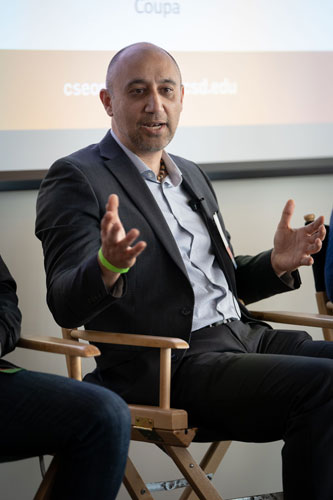
The 2020 CSE Winter Research Open House was held on January 31 and, for anyone interested in learning about UC San Diego’s Computer Science and Engineering Department, this was the place to be. The event featured a keynote on augmented reality, two rounds of student research presentations, an industry panel, open labs, a graduate student poster session and industry info sessions.
Keynote speaker Edward Wu (CSE ‘04), VP, Platform at Niantic and technical lead for Pokémon Go, showcased the company’s evolution and ongoing efforts to develop technology that connects people to one another and their surroundings.
“That's the fundamental mission that Niantic embarked upon,” said Wu, “not to create augmented reality. What we wanted to do is use technology to get people closer to their world.”
The company succeeded, engaging hundreds of millions of users. Wu cited an example close to home.
“My mom is an inveterate Pokémon Go player,” he said. “She's aligned with a group of several hundred other Taiwanese grandmas, who every morning – I kid you not – walk several kilometers together across the city.”
Wu went on to discuss Niantic’s future plans. As always, low latency is a major goal. But the company is also working to make augmented reality more lifelike, for example, recognizing actual people and structures and having game characters interact with them in more realistic ways.

Research Sessions and the Industry Panel
Immediately after Wu’s keynote, students, faculty and researchers hosted a number of breakout sessions. During the first round, people could choose between Computer Vision and Robotics, Sustainable Computing and Security and Program Languages. Later sessions included talks on Architecture, Bioinformatics and Machine Learning and AI.
The afternoon kicked off with an industry panel, featuring Ryne Chaloux (CSE ‘15) , senior software engineer and tech lead at AppFolio; Parand Darugar (CSE ’93), VP, service architecture at Coupa; and Alessandro Muti, VP and software engineer at WeWork. The panel was moderated by Professor Tajana Rosing.
The group touched on a wide range of topics: what they love about their work; the technologies that excite them; how they got where they are; where the industry is headed; the challenges they face; and what got them into computer science in the first place.
“Computer science is a very creative act. You're building things, you’re imagining things,” said Darugar.
Chaloux had a similar take: “I think what draws me to computer science is the challenge. When the challenge is done, that's boring, right? So, I like when things change faster and faster and faster. Which, especially in computer science, happens very quickly.”

Labs and Awards
A variety of labs, including Healthcare Robotics and Cognitive Robotics, demonstrated their work for excited participants. Upstairs, graduate students showed off their posters – everything from bioinformatics to applying augmented reality to surgery to cybersecurity.
Later, a number of companies held Industry Info Sessions, including Research Open House sponsors AppFolio, Marvell Semiconductor, Qimia and WeWork.
The day finished off with a reception and awards ceremony. Michael Barrow’s poster took first place in the industry category for Data Driven Tissue Models for Surgical Image Guidance. Audrey Randall was runner-up with Regional Congestion Control for Availability and Reliability in Andromeda’s Hoverboards.
Jens Luebeck won first place in research for Integrated Analysis of NGS and Optical Mapping Resolves the Complex Structure of Highly Rearranged Focal Amplifications. Saransh Gupta was runner-up with Digital and Scalable Processing in Memory for Big Data.
This was also the first year for the CSE Distinguished Alumni awards. Taner Halıcıoğlu (’96) and Tim Sherwood (’03) were honored. Halıcıoğlu worked at Loudcloud, Ebay and Facebook, where he was the first full-time employee. He now shares his vast knowledge and experience as a CSE lecturer and angel investor. The Halıcıoğlu Data Science Institute was named in his honor.
Sherwood is a professor of Computer Science and Associate Vice Chancellor for Research at UC Santa Barbara. Sherwood's contributions to novel program analysis, particularly his work on basic block vectors, fundamentally changed the research landscape. In 2016, he was awarded a SIGARCH Maurice Wilkes Award from the Association for Computing Machinery for his outstanding contributions to computer architecture.
“This was an amazing event,” said Department Chair Dean Tullsen after the open house. “We got to witness the excellent research being conducted at CSE, and I walked away inspired. I am grateful to everyone who had a hand in organizing this event.”
With another successful event completed, the CSE faculty, staff and student organizers are already planning for the next Research Open House – fall 2020.

